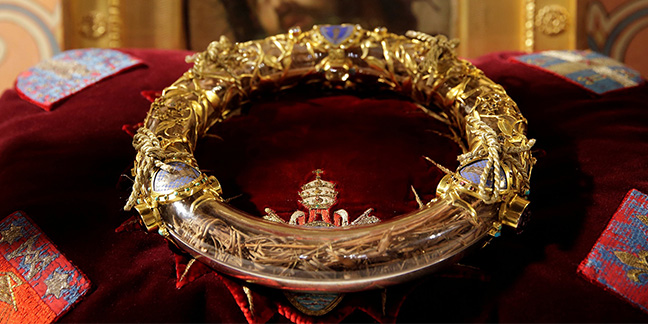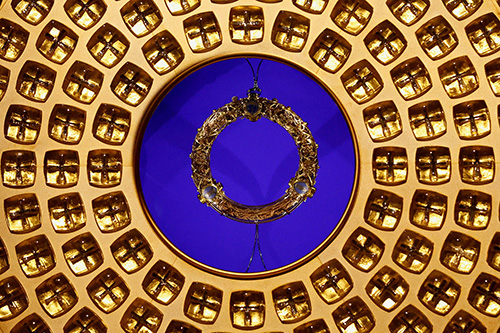 Everyone passing away leaves behind material traces of his or her life. The existence of a Jewish man, called Jesus of Nazareth, is supported by strong historical evidence. The question therefore is raised: Are the various artifacts associated with His life truly authentic?
Everyone passing away leaves behind material traces of his or her life. The existence of a Jewish man, called Jesus of Nazareth, is supported by strong historical evidence. The question therefore is raised: Are the various artifacts associated with His life truly authentic?
The history of relics – authentic or fake – is an amazing, fascinating chapter of Christian history through the centuries, especially the relics of Jesus Christ, which remain the most venerated and famous.
Here is a look at several of these holy artifacts that have survived to the present:
The holy cross
Martin Luther once said that “one could build a whole house using all the parts of the True Cross scattered around the world,” mocking the Catholic tradition of venerating relics and pilgrimages to places where they were located.
This is not true. According to research carried out in the 19th century, all the known fragments of the holy cross amount to less than one-ninth of its original volume.
The history of the holy cross begins with Constantine the Great, the first Christian emperor of Rome, who sent his mother Helena to Jerusalem.
On Sept. 14, 320, which would become the feast of the Exaltation of the Holy Cross, Helena discovered three wooden crosses and three nails in an old cistern not far from Golgotha, where Christ was crucified.
She divided Jesus’ cross into three pieces to be sent to Rome, Constantinople and Jerusalem. Even the titulus, stating “Jesus of Nazareth, King of the Jews,” as stated in St. John’s Gospel, was divided into two pieces.
Upon her return to Rome, she converted a part of her house into a chapel to host the relics she had brought back: a fragment of the cross, one half of the titulus and the three nails. Today, this is the site of the Basilica of the Holy Cross in Jerusalem, although in 1629 some of the relics were transferred to the newly reconstructed St. Peter’s Basilica by Pope Urban VIII.
The other two parts of the cross were divided again into smaller parts, currently spread throughout Europe.
It was common to divide a relic into smaller pieces in the belief that even the smallest fragment had the same sacred power as the whole relic.
The holy nails
How are we to establish which are the true ones, given that there are 36 “holy nails” in Europe, but only three of them nailed Jesus to the cross? Unexpected help came in 1968 from an archaeological discovery near Jerusalem.
There, four tombs were excavated and three nails found near the body of a young man, crucified between 6 and 65 A.D. They are rectangular in shape, 16 centimeters long and 0.9 centimeters wide at their thickest point. Comparison suggests that some “holy nails” are not genuine, since some are too long or made of silver.
The oldest sources say Helena discovered three nails of Jesus’ cross in Jerusalem. The first one is venerated today in the Roman Basilica of the Holy Cross in Jerusalem. The second nail was brought to Constantinople in 1354 by a Venetian merchant, Pietro Torrigiani.
The fate of the third nail is more difficult to clarify. According to Theodoret of Cyrus, part was embedded in the helmet of Constantine and another part melted into his horse’s harness.
There are two places where the emperor’s harness is venerated – Carpentras, France, and Milan, Italy. In 1576, Bishop Charles Borromeo, a leading figure of the Counter-
Reformation, carried the relic three times through the streets of Milan, praying for the end of a deadly plague. Since the plague ended, they had no doubt: the holy nail made the miracle.
The Longinus spear
 According to the legend, the Roman soldier Longinus was cured of cataracts when he pierced the side of Jesus on the cross and the blood and water flowed out. Longinus was later baptized and martyred.
According to the legend, the Roman soldier Longinus was cured of cataracts when he pierced the side of Jesus on the cross and the blood and water flowed out. Longinus was later baptized and martyred.
Pilgrims reporting from the Holy Land mention his spear up to the eighth century. The history of this relic goes on from Constantinople. Its ruler, Baldwin II, was forced to sell the spear staff to King Louis IX of France in order to collect resources to defend his Empire.
Two centuries later, Constantinople was invaded by Ottoman Turks led by Mehmed II on May 29, 1453. In 1492, Sultan Bayerid II proposed an agreement to Pope Innocent VIII: to welcome the sultan’s brother, Cem, a dangerous pretender to the Ottoman throne, to Rome. The agreement was that the brother could remain in Rome in exchange for the return of the Longinus headspear.
The relic arrived in Rome from Ancona, an Italian city on the Adriatic Sea, delivered by two cardinals. Pope Benedict XIV, in the 18th century, had many doubts on its authenticity. He asked the king of France to send the spear’s staff to Rome to verify the authenticity. The two pieces fit together perfectly.
The crown of thorns
In 1870, Charles Rohault de Fleury, a French architect, counted 139 thorns throughout Europe venerated as belonging to Christ’s crown of thorns. At least half of them are fake relics on the basis of studies carried out in Paris, where the true crown has been located for almost 800 years.
The hoop of the crown, about 12 centimeters large, is made of Juncus balticus, a plant species typical of the Eastern Mediterranean basin. According to some botanists, there were no more than 50 or 60 thorns in the crown.
There is a noteworthy clue in favor of the authenticity of the thorns: In the famous Turin shroud, scientists discovered a very high concentration of pollen grain from Gundelia tournefortii, a species of thistle only found in Judea, around the head area on the linen. This same thistle is one of the plants used in the crown of thorns.
When Jesus was taken down from the cross, it is likely that a disciple took the crown, hiding it somewhere in Jerusalem, where it remained a secret until the Roman Emperor Constantine granted religious freedom to Christians in 313.
Then in 1063, the Byzantine Emperor Constantine X ordered the crown to be moved to Constantinople.
Since Constantinople became the capital of the Latin Empire in 1204, many invaders assaulted the city. Therefore, in order to pay military expenses, King Baldwin II was forced to accept a offer from the French King Louis IX to buy it from him: 135,000 pounds in gold, an enormous price.
The Shroud of Turin
The most famous and venerated relic of Jesus Christ is an enigma that challenges the most advanced scientific knowledge: a simple linen sheet with an imprinted mystery, capable of justifying the religious belief of millions throughout the centuries.
The Gospels tell that Jesus, taken down from the cross, was wrapped in a linen sheet before being taken to the tomb. John writes that Peter, entering the tomb, saw bandages on the ground and the shroud folded in another place.
Tradition identifies that shroud with the relic that arrived in Turin in the 16th century after countless adventurous events between Edessa, Constantinople, France and Piedmont.
Whoever has the privilege of admiring the shroud during one of the rare public displays sees a single piece of linen cloth, herringbone fabric, 4.37 meters long and 1.13 meters wide.
On the cloth are visibly imprinted the front and back images of a human body with various wounds and injuries. Science has never determined how the images appeared.
Various traces of blood are also recognized – first of all on the hands, feet and ribs.
All the data obtained from observations of the cloth extraordinarily coincide with the Gospel narration.
The shroud has always been the subject of extraordinary veneration and also heated scientific debate. No other item has been the subject of such a systematic examination involving a wide range of disciplines, from history to genetics. Despite a carbon-14 test carried out in 1988, which traced the shroud back to the 13th or 14th century, many tests and researchers support the possibility of authenticity.
At least one point is clear: Even if the truth of Christianity does not depend on the shroud, the mystery hidden in it will never cease to fascinate.
— Deborah Castellano Lubov, OSV News


